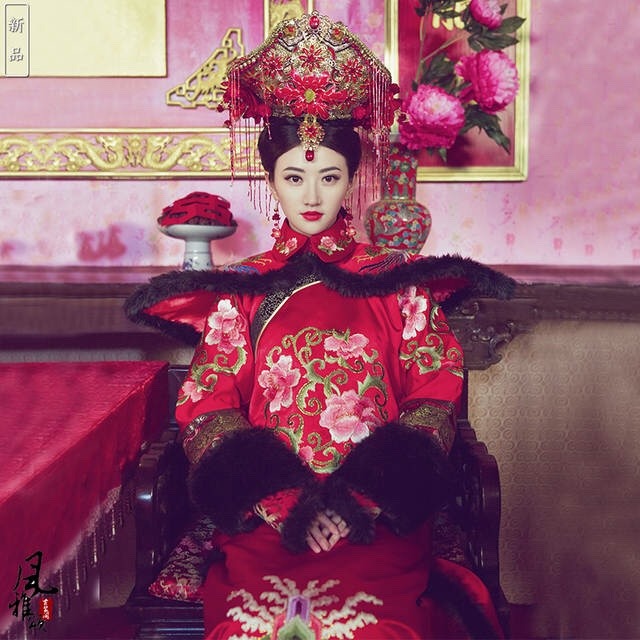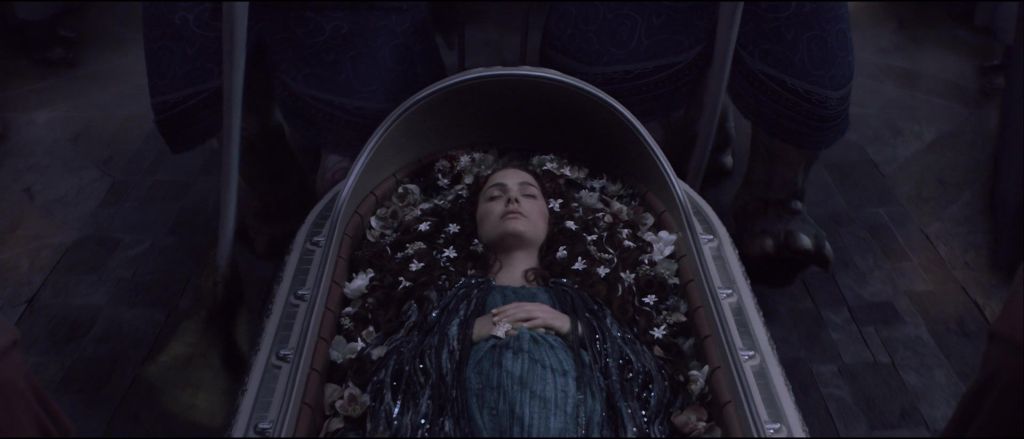Padmé Amidala is by far the best-dressed figure in the Star Wars universe. Her instantly recognizable wardrobe has spawned countless cosplays, merchandise, and fan art, all thanks to Trisha Biggar, who served as the prequel trilogy’s costume designer. Padmé’s intricate, colorful costumes in the Star Wars prequel series made a stark and refreshing contrast to the monotone aesthetic of the Empire when the character was first introduced in The Phantom Menace. While the queen-turned-senator from Naboo’s fashion seems to be out of this world, the inspirations behind it may surprise you.
Videos by ComicBook.com
Three costumes, in particular, highlight Biggar’s references from cultural dress, historical periods, and artistic references.
1) The Throne Room Gown From Star Wars: The Phantom Menace

This imposing, eye-catching gown was not only the first costume viewers saw Padmé, or Queen Amidala, in Phantom Menace, but is perhaps the most often associated with her character. The bright red gown, white face, and fur trim is now forever synonymous with the Queen of Naboo, Biggar found inspiration in ancient and imperial China. Red in Chinese culture is a popular color, given that it represents luck and prosperity, and is forbidden to be worn at funerals. Furthermore, the rich embroidery throughout Queen Amidala’s gown and the flared neck frill with standing color harkens back to styles worn by the Qing Dynasty.


The elaborate hair and makeup choices for Amidala’s look here also share a strong similarity to beauty practices in Ancient China. The complexity of the Queen’s hairstyle and headpiece echoes the Ancient Chinese tradition of incorporating jewelry into an elbraote hairstyle that was popular during the Tang Dynasty in the 700s.


Biggar also drew inspiration from that period for Amidala’s makeup, taking the white face makeup with red lipstain arranged in specific, meaningful patterns and reinterpreting it for Naboo royalty.
2) The Gold Travel Costume From Attack of the Clones

For this costume in Attack of the Clones, Biggar drew inspiration from the historical dress of another empire: Russia. As Padmé, now a member of the galactic senate, and Anakin travel from Coruscant to her home planet of Naboo, she dons another intricate and spectacular gown. Biggar strove for this look of Padmé’s to resemble a Russian ball gown.


When this costume is put alongside these photos of Grand Duchess Xenia Alexandrovna and Princess Orlova-Davydova, it nearly blends in perfectly. Both women wore traditonal Russian dress from the 17th century attending masquerade balls in 1903. It’s clear Biggar achieved her intention. The half-circle helmet of Padmé wears is clearly a smaller and sturdier version of the ornate headpieces the Russian royals wore.

Further parallels can be drawn in the extremely detailed embroidery on both dresses — Padme and the Grand Duchess’s — and well as how different fabrics are draped on the garments. Both gowns have embellishment around their neck and shoulders, capes, and patterning running down the center of their dresses.
3) The Water Funeral Gown From Revenge of the Sith

Parting is such sweet sorrow. For this costume, which a deceased Padmé wears at her funeral in Naboo at the end of Revenge of the Sith, Biggar channeled William Shakespeare’s most famous work: Hamlet.
In the famous tragedy, Hamlet’s love Ophelia drowns after falling into a brook while making a wreath of flowers on a willow tree. The similarities here are obvious. Swathed in shimmering, shifting green and blue fabric gives the effect of Padmé floating in water. The plethora of flowers that surround her add an ethereal quality and call back to what Ophelia was doing before she fell to her death.
It seems that Biggar and the Revenge of the Sith wardrobe team perhaps used British artist Sir John Everett Millais’s famous portrait Ophelia as a direct reference when crafting Padmé’s sendoff.

Both Millais’s Ophelia and Padmé are clothed in gauzy fabrics and float amongst the water and artfully arranged flowers. Pulling from Shakespeare works for this aspect of the Skywalker saga, since both Ophelia and Padmé had doomed romances with tragic figures. It also makes for a stark contrast to Anakin Skywalker’s demise and rebirth into Darth Vader. Whereas Anakin is destroyed by violent and volatile flames, Padmé is peacefully laid to rest in a solemn, watery scene.
Most would assume that Padmé Amidala’s wardrobe are fanciful, fantastical creations from a galaxy far, far way. In reality, they actually are painstakingly crafted pieces that say as much about Earth as they do Naboo.









